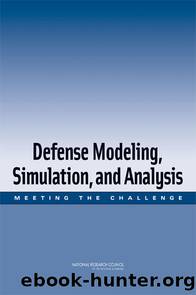Defense Modeling, Simulation, and Analysis: MEETING THE CHALLENGE by National Research Council of the National Academies

Author:National Research Council of the National Academies
Language: eng
Format: epub
Tags: Conflict and Security Issues : Military and Defense Studies
Publisher: NATIONAL ACADEMY PRESS
Published: 2006-09-30T00:00:00+00:00
Although these steps have been developed and proven successful in the context of large, complex, and strategic decisions requiring analytic support, a streamlined version is likely to be useful even for short-term, quick-and-dirty activities as well as for preparing MS&A for training and exercise in tactical contexts.
These three steps may take a few days to several weeks, or longer, if trust must be gained from scratch. Previous successful uses of MS&A in similar problem contexts can shorten this time. For complex strategic decisions, for which no precedent exists, iteration between the MS&A team and the decision makers at each step can produce insights for restructuring and simplification.
There exists little research to guide MS&A practitioners in these steps. It is fair to say that the first two steps are more of an art than a science, while some research support has been developed for the third step in specific MS&A subdisciplines. For example, guidelines for the third step have been developed for studying causal dynamic systems (Sterman, 2005), objectives hierarchies (Keeney, 1992), decision trees and influence diagrams (Clemen, 1996), and Bayesian belief networks.
A related issue is the choice of the level of detail for an MS&A activity. Often, a little modeling and analysis goes a long way. Rapid prototyping, followed by restructuring, followed by more detailed modeling is usually a better strategy than investing large resources in a one-shot, large-scale MS&A activity. An arguably ideal MS&A process would involve an iteration of models that are initially too simple, to models that are too detailed and complex, back to simpler models that capture the essence of the complex models yet strip details from them that are unnecessary for the final use by decision makers. In such an iterative process, models can be simplified in many ways, including aggregation of variables, approximate computations, and omission of unimportant variables. Since these simplifications have implications for the uncertainty and accuracy of the output, the MS&A team must understand the implications and communicate them carefully to the decision makers and end users of their products. The involvement of decision makers and end users in these choices is extremely important if the MS&A development is to be matched to their needs. The committee believes that this practice is already followed by the best MS&A practitioners but must become more widespread, especially as decision makers become more dependent on MS&A to supplement their experience and intuition.
Download
This site does not store any files on its server. We only index and link to content provided by other sites. Please contact the content providers to delete copyright contents if any and email us, we'll remove relevant links or contents immediately.
| Automotive | Engineering |
| Transportation |
Whiskies Galore by Ian Buxton(41716)
Introduction to Aircraft Design (Cambridge Aerospace Series) by John P. Fielding(33013)
Small Unmanned Fixed-wing Aircraft Design by Andrew J. Keane Andras Sobester James P. Scanlan & András Sóbester & James P. Scanlan(32681)
Craft Beer for the Homebrewer by Michael Agnew(18078)
Turbulence by E. J. Noyes(7890)
The Complete Stick Figure Physics Tutorials by Allen Sarah(7260)
Kaplan MCAT General Chemistry Review by Kaplan(6817)
The Thirst by Nesbo Jo(6750)
Bad Blood by John Carreyrou(6470)
Modelling of Convective Heat and Mass Transfer in Rotating Flows by Igor V. Shevchuk(6351)
Learning SQL by Alan Beaulieu(6155)
Weapons of Math Destruction by Cathy O'Neil(6079)
Man-made Catastrophes and Risk Information Concealment by Dmitry Chernov & Didier Sornette(5872)
Digital Minimalism by Cal Newport;(5578)
Life 3.0: Being Human in the Age of Artificial Intelligence by Tegmark Max(5401)
iGen by Jean M. Twenge(5319)
Secrets of Antigravity Propulsion: Tesla, UFOs, and Classified Aerospace Technology by Ph.D. Paul A. Laviolette(5234)
Design of Trajectory Optimization Approach for Space Maneuver Vehicle Skip Entry Problems by Runqi Chai & Al Savvaris & Antonios Tsourdos & Senchun Chai(4951)
Electronic Devices & Circuits by Jacob Millman & Christos C. Halkias(4861)
